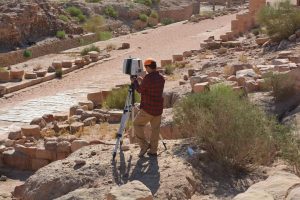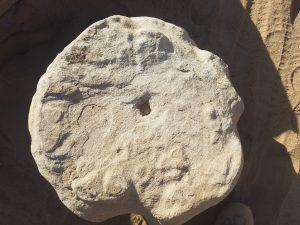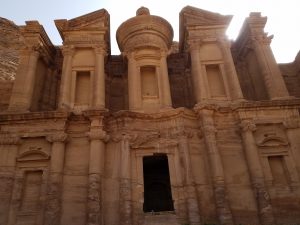
MY FIRST TRIP OUTSIDE OF THE UNITED STATES
Robert John Szczotka, 2018 Member Supported Fellowship Recipient
I would like to thank ASOR and the donors that provided this fellowship for the invaluable experience that I was able to be apart of because of their support. My first dig experience taught me so much
about archaeology and the methods that are used in the field. During the dig season I also learned so much from all the staff and supervisor who were always willing to share then knowledge with the students. The support from ASOR was a big help in making it possible for me to go on this dig.
This summer I participated in the Petra Garden and Pool complex 2018 field season. The dig was next to the Great Temple in Petra, Jordan. The projects director was Dr. Leigh-Ann Bedal from Penn State Erie, The Behrend College. The goal of the project was to better understand the monumental pool and garden complex build by the Nabateans. It is believed that the pool and garden complex was a power symbol to show off the Nabatean’s wealth and skill at collecting water. During the field season we explored the main street of Petra and, as a group, we hiked up to the Ad Deir or “the Monastery”. During our stay we saw the many great sights of Petra such as the Siq, the Al-Khazneh or “the Treasury”, the stadium, the royal tombs, and the Byzantine church. Also, during our field season we visited the Neolithic village at Beidha and the site of “Little Petra” or Siq al-Barid, which is north of the main city of Petra.
I learned from this field season that archaeology is more than just digging. Archaeology uses the artifacts that are found to give you dates of features and of soil layers. Before the dig, Dr. Bedal knew that my interest was in Roman archaeology. She gave me the task of studding Van Meter’s Handbook of Roman Imperial Coins so during the field season I
could help with identifying the coins that were found on the site. Then when the field season came, I dug in the morning and afternoon. I also participated in pottery washing later in the afternoon. During the field season, I dug in trenches 28 and 27 which both were new trenches that had not be dug before. Another trench, trench 26, was a trench that had been dug before but was refilled by the flash floods that Petra suffers from. Also, trench 20 was apart of the Great Temple Complex that had not been excavated before. During the evenings it was my job to do a preliminary cleaning of the coins found on the site. The coins were put in a mixture of water softener and distilled water and allowed to soak for a few days. Then, the layer of corrosion was removed by scraping the surface of the coin with an X-acto knife. This process was repeated several times until the dirt and corrosion was removed from the coin; then, a fiber glass pen was used to polish the surface of the coin. The fiber glass would be used on the coin several times to polish the surface enough to see the design on the coin. The site produced both Roman and Nabatean coins with images of both Roman emperors and Nabatean Kings. The coins were then photographed and added to the projects database. The coins were also given a code that allowed them to be searched for within the database. We tried to identify the coins that had visible designs and features on them. One of the coins is believed to be a Nabatean coin from the rein of a late Nabatean king. Some of the coins were in rough shape and designs were almost nonexistent; others were too thin to be cleaned without damaging them. After the project, the coins will be given to ACOR in Amman so that they can be cleaned thoroughly by professionals. Towards the end of the field season, I helped Dr. Thad Wasklewicz scan the site with his 3D laser scanner. We scanned the whole site and the newly dug trenches and some older trenches. The scanning was important because it allowed the trench to be
refilled with dirt to preserve them but also allows the archaeologists to study the trenches without having to dig out the trench again. The scans can also show details that are hard to see with the human eye. The program that the scans were added to allows all the scans to be added to a point cloud so the whole site can be viewed in a 3D model. The trenches can also be viewed separate from the rest of the site so they can be viewed in more detail.
Robert John Szczotka is currently a Junior at Penn State University Park where he is majoring in History and Classics. He is also an Eagle scout of troop 93 in Pennsylvania.
Learn more about the Petra Garden and Pool Complex at the PGPC 2018 Facebook page.


